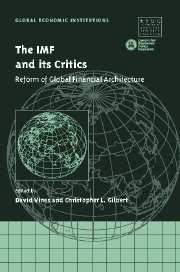Book contents
- Frontmatter
- Contents
- List of figures
- List of tables
- List of contributors
- Acknowledgements
- Introduction
- 1 The IMF and international financial architecture: solvency and liquidity
- 2 Progress towards greater international financial stability
- 3 International coordination of macroeconomic policies: still alive in the new millennium?
- 4 The Report of the International Financial Institution Advisory Commission: comments on the critics
- 5 Reforming the global financial architecture: just tinkering around the edges?
- 6 The IMF and capital account liberalisation
- 7 How should the IMF view capital controls?
- 8 The resolution of international financial crises: an alternative framework
- 9 Whose programme is it? Policy ownership and conditional lending
- 10 The IMF and East Asia: a changing regional financial architecture
- 11 The role of the IMF in developing countries
- 12 Argentina and the Fund: anatomy of a policy failure
- 13 Countries in payments' difficulties: what can the IMF do?
- 14 Accountability, governance and the reform of the IMF
- 15 The IMF at the start of the twenty-first century: what has been learned? On which values can we establish a humanised globalisation?
- Index
- References
1 - The IMF and international financial architecture: solvency and liquidity
Published online by Cambridge University Press: 04 December 2009
- Frontmatter
- Contents
- List of figures
- List of tables
- List of contributors
- Acknowledgements
- Introduction
- 1 The IMF and international financial architecture: solvency and liquidity
- 2 Progress towards greater international financial stability
- 3 International coordination of macroeconomic policies: still alive in the new millennium?
- 4 The Report of the International Financial Institution Advisory Commission: comments on the critics
- 5 Reforming the global financial architecture: just tinkering around the edges?
- 6 The IMF and capital account liberalisation
- 7 How should the IMF view capital controls?
- 8 The resolution of international financial crises: an alternative framework
- 9 Whose programme is it? Policy ownership and conditional lending
- 10 The IMF and East Asia: a changing regional financial architecture
- 11 The role of the IMF in developing countries
- 12 Argentina and the Fund: anatomy of a policy failure
- 13 Countries in payments' difficulties: what can the IMF do?
- 14 Accountability, governance and the reform of the IMF
- 15 The IMF at the start of the twenty-first century: what has been learned? On which values can we establish a humanised globalisation?
- Index
- References
Summary
The emergence of the current global architecture
The starting point of our discussion is the global frameworkof international institutions, set up at the 1944 Bretton Woods Conference. The IMF was perhaps the chief element of this framework and passed its initial two decades within its confines. In this framework, the IMF helped to manage balance of payments adjustment within a global system of pegged but adjustable exchange rates. The IMF now does something looser than this – it exercises surveillance over and influence on macroeconomic policies worldwide. In this section we set out how and why this change came about, describing how the Fund's role has changed as the overall framework has changed. In subsequent sections we consider the role for the Fund within this new framework. Its central role has come to be that of helping to manage macroeconomic stability in developing countries, and, in particular, the management of international financial crises. Crucial to this is its role in responding in appropriate and differentiated ways to liquidity and solvency crises. A discussion of this role will form the focus of this chapter.
The global architecture of the golden age
The post-war world into which the Bretton Woods' twins (the IMF and the World Bank) and the GATT were born was one in which the main issues were: to prevent a collapse in economic activity and employment; to promote growth; to avoid the emergence of payments imbalances; to promote the growth of international trade and avoid a slide back into the protectionism of the 1930s; and to promote economic development through international lending.
- Type
- Chapter
- Information
- The IMF and its CriticsReform of Global Financial Architecture, pp. 8 - 35Publisher: Cambridge University PressPrint publication year: 2004
References
- 1
- Cited by

